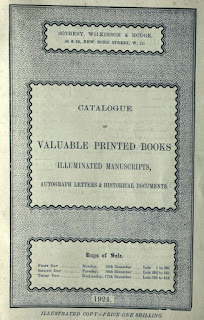When I was in New York at Christmas I spent some time at the Watson Library in the Metropolitan Museum of Art, mainly looking at the part of the Robert Lehman Archive pertaining to his illuminations. I'll be doing a separate post about it in due course, because it tells us a lot about when and where he acquired them, and explains the weird numbering of items that appears in de Ricci's Census.
Today I'll just highlight one provenance discovery that came out of this work, relating to the Antiphonary of Berardo da Teramo (of which an image is shown above), one of the most important illuminated manuscripts from Abruzzo, of the second quarter of the 14th century.
The manuscript is known today only as 15 single leaves. At the top of the first page (now in the Cini collection, Venice), in gold letters, is "Do(m)pn(u)s Berardus de Teramo fecit hoc opus":
Berardo is usually assumed to have been the artist, though he could perhaps have been the scribe. Along the bottom edge, also in gold, is a record that archpriest Jacopo of San Flaviano had it made for the soul of Matteo, curate of [San Benedetto a] Gabiano: "Archip(re)sbit(er) Jac(obus) de S(an)c(t)o Flaviano fec(it) fieri hoc op(us) p(ro) a(n)i(m)a frat(ri)s Mathei p(re)positi Cabiani cui(us) a(n)i(m)a benedicatur" (as usual, click the image to enlarge it):The manuscript has been published several times in the past two decades, where more details of its origins are provided[1]. In these publications it is usually stated that the manuscript was broken up at an unknown date; the earliest known modern provenance is for some of the single illuminated leaves which were owned by John Murray, in Florence in 1925.[2]
None of the recent writers was aware that the intact manuscript was sold as "The Property of a Gentleman" at Sotheby's, 15 December 1924, lot 530, and reproduced as the frontispiece:
It was bought by Quaritch, perhaps for Murray, for £150:
Edit, 22 March 2022: Quaritch tweeted in response to this blopost that they in fact bought the MS for [Tamaro] de Marinis, not Murray.
What makes it even more surprising that this catalogue has been overlooked in all subsequent literature, is that it was cited by de Ricci (Census, II, p. 1708) in his description of some leaves in the Lehman Collection that he (incorrectly) believed to come from the Antiphonal of Berardo da Teramo, and for which he (correctly) cited other leaves which were then in the Hoepli collection:
The 1924 Sotheby's catalogue description provides several details that were not previously known about the parent manuscript, including the facts that it had:
- 223 leaves, with foliation starting at 7 (i.e. there was probably once a
calendartable of contents on 6 leaves). The St Lucy leaf has the folio number "xxxvj" and a catchword, suggesting that the volume was composed of quires of 8 leaves (i.e. fols. 7-12, 13-20, 21-28, 29-36, etc.) - 15 large historiated initials, including "two miniatures representing baptisms" (only 1 of which is currently known)
- 19 smaller historiated initials (only 1 of which, at Amherst, is currently known)
- (fol. 7r) (1st Sunday in Advent) Last Judgement
Cini, Inv. 22084 (2016 exh. cat., no. 67a)
- (fol. 33r) (4th Sunday in Advent) Figure blowing a horn ("Canite tuba ...")
Mead Art Museum, Amherst College, MA, Inv. Inv. 1961.16 (identified for the first time by Francesca Manzari in the forthcoming catalogue of the collection to which the Adoration of the Magi leaf (see below) belongs; I am grateful to her for sharing her unpublished catalogue entry)
- (fol. 36v) (13 December) Martyrdom of St Lucy
Cini, Inv. 22088 (2016 exh. cat., no. 67b)
- (fol. 48r) (Christmas) A kneeling saint, praying to the Dextera Dei
Whereabouts unknown (formerly Christie’s, November 24 1993, lot 3 (ill.), the saint identified as St James the Less; Köller, Zurich, 18 March 2008, lot 3411, and again 20 September 2008, lot 3804; Freuler, 2013, p. 634, identifies the scene as Christ Blessed by His Father -- even though the figure does not have a cruciform halo).
- (fol. 49r) (25 Dec.) Nativity
Zurich, Private collection (according to Freuler, 2013, p. 634; formerly in the Lehman Collection at The Met, New York; Lehman M.165; de Ricci, Census, II, p. 1707 no. B.13)
- (fol. 57r) (26 Dec.) Stoning of St Stephen
Cini, Inv. 22087 (2016 exh. cat., no. 67c)
- (fol. 84r) (6 Jan.) Adoration of the Magi
Tokyo, Museum for Western Art, Naito Collection (formerly Hoepli, 7-9 April 1927, lot 332, pl. LXXXIII; Hoepli, 11-12 June 1929, lot 24)
- (fol. 87v) (13 Jan.) Baptism of Christ
Whereabouts unknown (formerly Hoepli, 11-12 June, 1929, lot 23; Mensing, 22 November 1929, lot 66; and Christie’s, 29 Dec. 2016, lot 15)
- (fol. 105r?)* (15 Jan.). St Maurus saving St Placidus from Drowning
Private collection, Milan (Freuler, 2013, pp. 634-41; formerly Hoepli, 7-9 April 1927, lot 331, pl. LXXXII(acc. to Freuler -- I have not yet verified this); [Added, 29 Nov. 2025:] Hoepli, Zurich, 18-21 May, 1931, lot 54, pl. V)
- (fol. 115r) (20 Jan.) Martyrdom of St Sebastian
Cini, Inv. 22086 (2016 exh. cat., no. 67d)
- (fol. 129v) (2 Feb.) Presentation in the Temple
Cini, Inv. 22085 (2016 exh. cat., no. 67e)
- (fol. 147r) (21 Mar.) St Benedict and Monks
Cini, Inv. 22090 (2016 exh. cat., no. 67f)
- (fol. __) (2nd Sunday in Lent) Isaac and Jacob
Genoa, private collection
- (fol. 213r) (Holy Thursday) Arrest of Christ
Cini, Inv. 22185 (2016 exh. cat., no. 67g)
- (fol. 221r)* (15 Aug.) Assumption of the Virgin
Cini, Inv. 22089 (2016 exh. cat., no. 67h)








No comments:
Post a Comment
** PLEASE INCLUDE YOUR NAME IN YOUR COMMENT **
I may ignore and delete anonymous comments